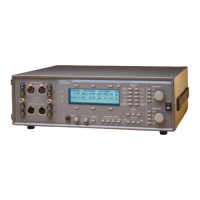measured frequency of the signal. The only available unit is Hz, but
the upper right soft key can be used to turn the reading off.
Because of the nature of the calculation, only one channel can be
used at a time. Pressing either the INPUT A or OUTPUT A button will
select the A channel, turning on the generator channel A, turning off
the generator channel B, and enabling the analyzer channel A.
Pressing either the INPUT B or OUTPUT B button will select the B
channel, turning on the generator channel B, turning off the generator
channel A, and enabling the analyzer channel B.
The measuring technique is quite accurate at low device input
impedances, and less sensitive at high impedances. The upper limit of
the measurement’s accuracy is about 20 kΩ, so greater impedances
are only displayed as ‘>20k OHM’.
The sweep mode can be used to sweep the measurement over a
range of frequencies to obtain a graph of the impedance vs.
frequency. One common use of this is in measuring loudspeaker
impedance curves.
The voltage divider calculations rely on the assumption that the input
impedance of the device-under-test is purely resistive. If it is very
reactive, significant errors can result. If the impedance curve shows
very sharp peaks or dips, one should suspect that the load is very
reactive. A reactive load will have an impedance that varies with
frequency.
ATTENTION: Upon entering the Gen Load
measurement function, the generator is
automatically set to 200 mV amplitude and the
output turned on, so be sure that the device
can handle this voltage before connecting it and selecting
the Gen Load function. After entering Gen Load
measurement function, the amplitude can be changed using
the AMPLITUDE controls and the frequency can be changed
using the FREQUENCY controls.
4 Functions
Gen Load Function Descriptions
4-38 ATS-1 Dual Domain User's Manual

